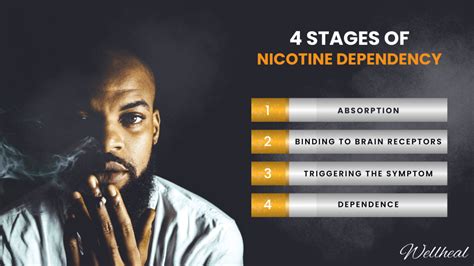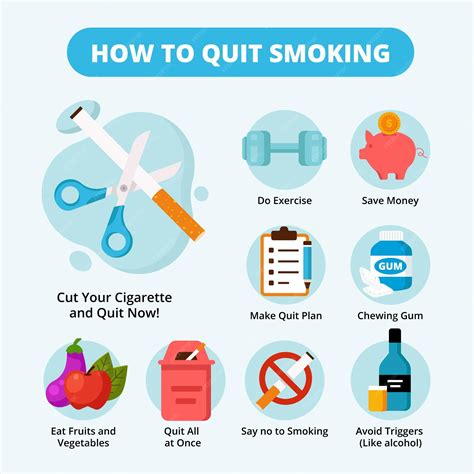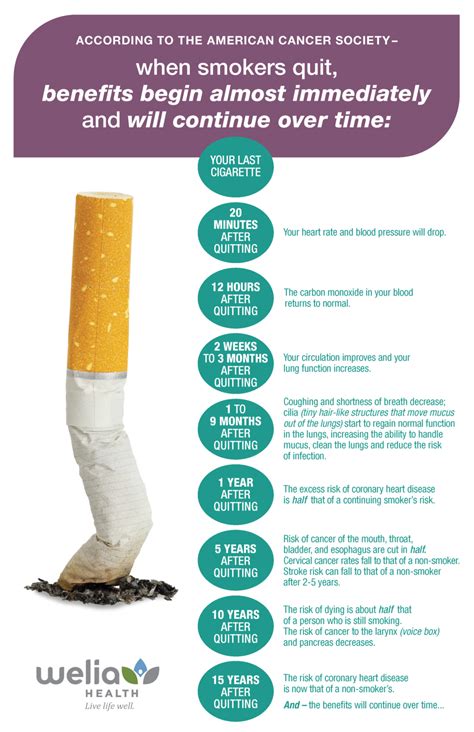Intro
Discover 5 effective tips to quit smoking, overcoming nicotine addiction with healthy alternatives, and managing withdrawal symptoms for a smoke-free life.
Quitting smoking is a journey that requires dedication, persistence, and the right strategies. With the numerous health risks associated with smoking, including heart disease, lung cancer, and stroke, it's no wonder that many smokers are looking for ways to kick the habit. However, quitting can be challenging, and it's common for smokers to experience withdrawal symptoms, cravings, and relapses. Despite these challenges, many people have successfully quit smoking, and with the right approach, you can too. In this article, we'll explore the importance of quitting smoking, the benefits of a smoke-free life, and provide you with practical tips to help you overcome nicotine addiction.
The decision to quit smoking is a significant one, and it's essential to understand the motivations behind your desire to stop. Whether it's to improve your health, protect your loved ones from secondhand smoke, or simply to save money, having a clear reason for quitting can help you stay focused and committed to your goal. Additionally, understanding the benefits of quitting can be a powerful motivator. Within 20 minutes of quitting, your heart rate and blood pressure decrease, and within 12 hours, the carbon monoxide levels in your blood return to normal. As you progress on your journey, you'll experience even more significant health improvements, including reduced risk of heart disease, stroke, and various types of cancer.
Quitting smoking is a process that requires patience, self-care, and support. It's not just about stopping the physical act of smoking; it's also about addressing the emotional and psychological aspects of nicotine addiction. Many smokers use cigarettes as a way to cope with stress, anxiety, or boredom, and it's essential to find alternative strategies to manage these feelings. Whether it's through exercise, meditation, or creative activities, finding healthy ways to cope with emotions can help you stay on track and avoid relapse. With the right mindset and strategies, you can overcome the challenges of quitting and live a healthier, smoke-free life.
Understanding Nicotine Addiction

How Nicotine Affects the Brain
Nicotine affects the brain by altering the levels of neurotransmitters, such as dopamine, serotonin, and acetylcholine. These chemicals play a crucial role in regulating mood, motivation, and cognitive function. When nicotine is present, it can enhance the release of these neurotransmitters, leading to feelings of pleasure and relaxation. However, when nicotine is absent, the brain can experience a decrease in these chemicals, leading to withdrawal symptoms such as anxiety, depression, and irritability. By understanding how nicotine affects the brain, you can develop strategies to manage withdrawal symptoms and stay on track with your quit plan.5 Tips to Help You Quit Smoking

Managing Withdrawal Symptoms
Withdrawal symptoms can be challenging, but there are strategies to manage them. Here are some tips to help you cope with withdrawal: * Stay hydrated: Drink plenty of water and healthy fluids to help flush out nicotine and its byproducts. * Get enough sleep: Aim for 7-8 hours of sleep per night to help regulate mood and reduce cravings. * Practice relaxation techniques: Engage in activities such as meditation, deep breathing, or yoga to help manage stress and anxiety. * Use NRT: Nicotine replacement therapy can help manage withdrawal symptoms and cravings. * Stay active: Engage in physical activities to help manage stress and cravings.Benefits of Quitting Smoking

How to Stay Smoke-Free
Staying smoke-free requires ongoing effort and commitment. Here are some tips to help you stay on track: * Avoid triggers: Identify situations that trigger cravings and avoid them whenever possible. * Stay active: Engage in physical activities to help manage stress and cravings. * Get support: Continue to attend support groups or talk to a counselor to help you stay motivated and accountable. * Reward yourself: Celebrate milestones and reward yourself for staying smoke-free. * Stay positive: Focus on the benefits of quitting and remind yourself of your reasons for quitting.Common Challenges and Solutions

Overcoming Relapse
Relapse is a common experience for many smokers, but it's not a failure. Here are some tips to help you overcome relapse: * Don't be too hard on yourself: Relapse is a normal part of the quitting process, and it's essential to be kind and compassionate with yourself. * Identify triggers: Reflect on the situations that led to relapse and develop strategies to avoid them in the future. * Get support: Talk to a counselor or attend a support group to help you stay motivated and accountable. * Stay active: Engage in physical activities to help manage stress and cravings. * Reward yourself: Celebrate small milestones and reward yourself for staying smoke-free.Conclusion and Next Steps

We invite you to share your experiences, tips, and advice on quitting smoking in the comments below. Your story can inspire and motivate others to take the first step towards a smoke-free life. Additionally, if you have any questions or concerns, please don't hesitate to ask. We're here to support you on your journey to a healthier, smoke-free life.
What are the benefits of quitting smoking?
+Quitting smoking has numerous benefits, including improved lung function, reduced risk of heart disease, and improved mental health.
How can I manage withdrawal symptoms?
+Withdrawal symptoms can be managed by using NRT, staying hydrated, getting enough sleep, and practicing relaxation techniques.
What can I do to stay smoke-free?
+To stay smoke-free, it's essential to avoid triggers, stay active, get support, and reward yourself for small milestones.
